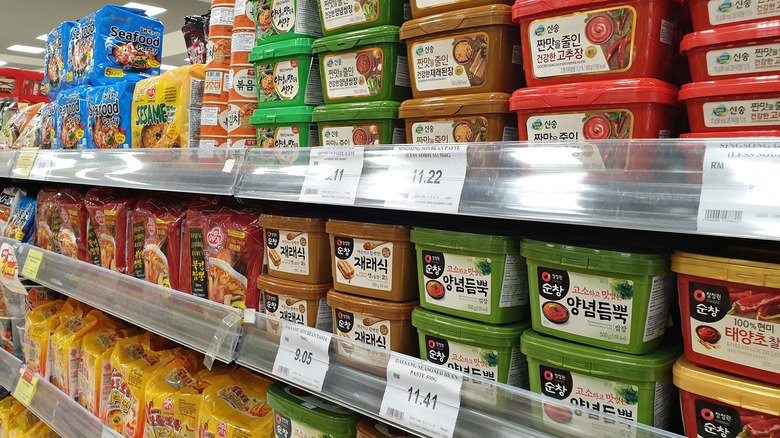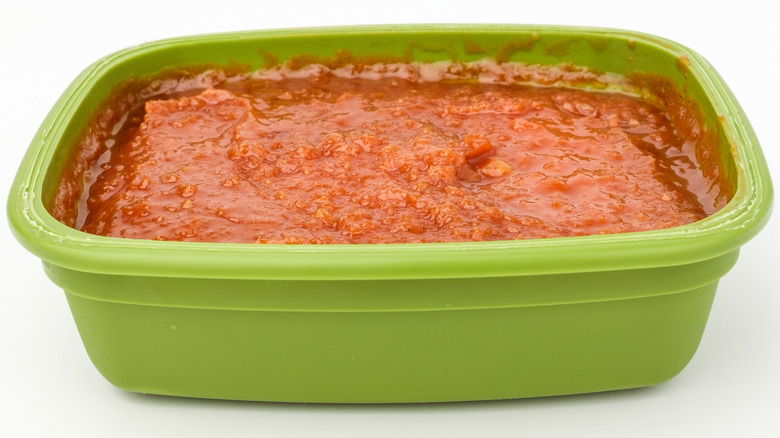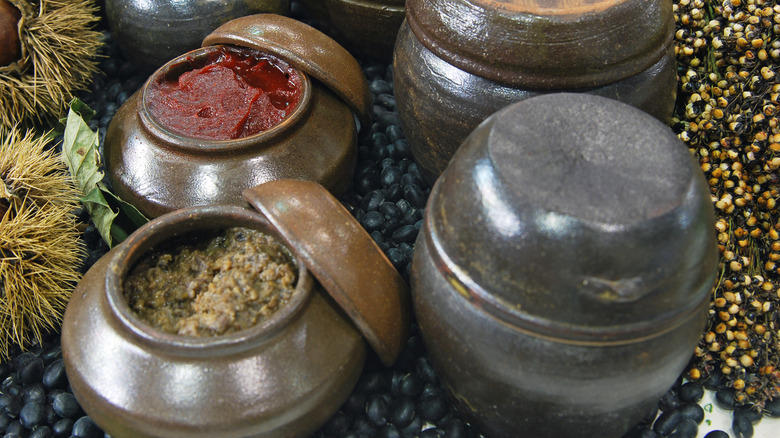Ssamjang: What It Tastes Like And Why It's Not The Same As Gochujang
When it comes to understanding ssamjang, knowing it's different from gochujang (which is different from gochugaru) is a good place to start. But what if you don't know what gochujang is? Worry not, for the answer is simple: Gochujang is a spicy paste that's popular in Korea, where it's used to add complexity to foods. Dark red in color, tasting hot and fermented with hints of salty, savory, and sweet, it's sort of like the Korean version of sriracha.
Specifically, gochujang is made by sun-drying and fermenting soybeans along with red chili powder, salt, and sweet rice. This practice dates back hundreds of years, with the process occurring inside big earthen vessels known as "onggi." The resulting paste is commonly added to dips, rice, and stews. Now, as gochujang makes its way further into Western cuisines, folks are increasingly mixing it with other condiments like barbecue sauce, ketchup, and mayo or adding it to dishes like burgers, fries, hot dogs, salads, and tacos. So, how does this compare to ssamjang?
Gochujang is a ssamjang ingredient
The Korean term "ssamjang" can be translated to "sauce for wraps," which gives you a good idea of its main function. However, it's sometimes used as a dipping sauce or general condiment, as well, adorning anything from dumplings, eggs, kimchi, and meat to noodles, rice, veggies and more. Like gochujang, it adds depth to recipes, though their components do differ a decent amount.
Ssamjang actually consists partially of gochujang as well as another fermented soybean paste called "doenjang." Those two primary ingredients are further enhanced with sesames and minced alliums (think scallions, onions, or garlic). Sweeteners like agave syrup, brown sugar, and honey are also often incorporated. Variations exist, like tofu ssamjang, nut ssamjang, and namul ssamjang (with its crunchy, minced beans). Even briny sardines are sometimes added. Essentially, ssamjang is gochujang with a bunch of other things added in for balance, especially when it comes to rich umami.
The taste of ssamjang can change a lot depending on specific additions, but in a general sense, ssamjang is fairly varied in flavor. It's tangy and hot just like gochujang, yet its saltiness, savoriness, and sweetness can all become more pronounced. Additionally, the alliums add an element of freshness while the sesame brings in a hint of toastiness. Appearing dark red in color, ssamjang can look similar to gochujang. Still, its chunkiness and typically green containers (when sold online or in Korean stores) both visually set it apart. Nevertheless, ssamjang's similarity to gochujang is no coincidence.
What are Korean jang condiments?
Sharp-eyed readers may have noticed that both "gochujang" and "ssamjang" have the same suffix, as does "doenjang," and there's a reason for this. All three belong to the jang family of Korean condiments. As mentioned, doenjang is another fermented soybean paste, which points to their unifying theme — the fermented soybeans. Jang in particular is a mass of squished, dried, and condensed soybeans, and it forms the basis of its ubiquitous culinary category in Korea. Although the stuff is often accentuated with other flavors — like in the cases of gochujang and ssamjang — jang itself is decidedly savory, noticeably fermented, and somewhat salty.
Soybeans come from nearby Manchuria, which is why they're traditionally used in Korean cuisine much more often than in Western cuisines. In fact, their usage there dates back thousands of years. Indeed, the ever more popular adoption of ssamjang, gochujang, and doenjang is the result of a long-fermenting, now delicious tradition.


